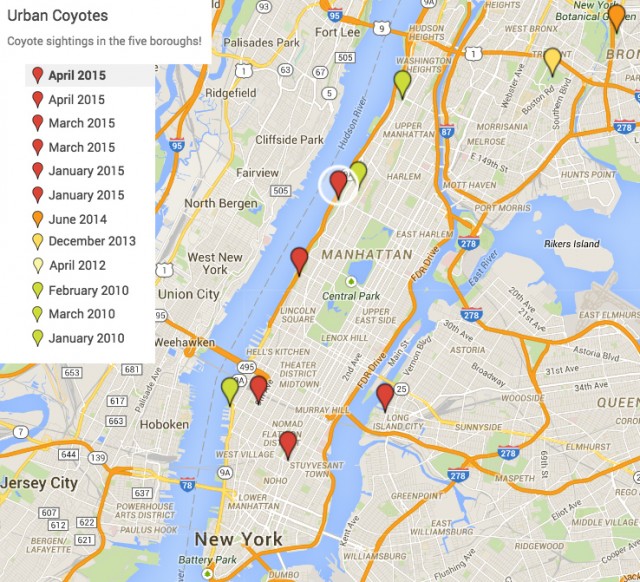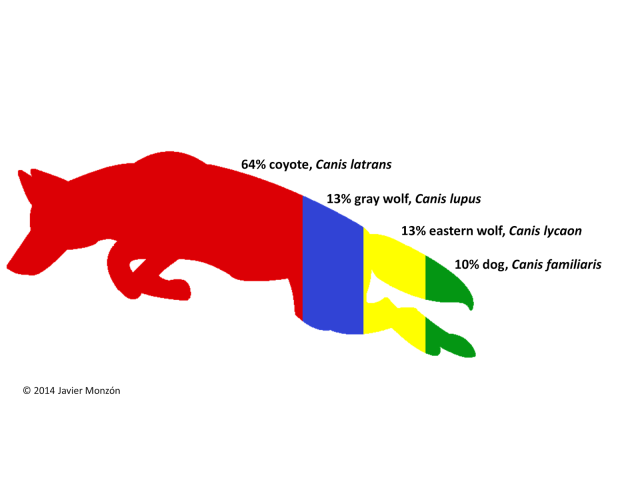This morning, an adventurous coyote led police on a futile chase through Riverside Park on the Upper West Side, the second to be seen in Manhattan in April, and the sixth NYC coyote sighting of 2015, a record-breaking pace.
The “Riverside Park coyote” has, as of our writing, escaped the ignominy of the tranquilizer dart and carry case. But what’s going on with coyotes and New York? Are they scoping out the real estate? Do they have long term plans? Last month Madeleine Levin investigated, by joining a walk with experts in the Bronx – the not-so-secret launch pad for coyote invasions of Manhattan. [UPDATED with NBC coverage of continuing coyote hunt on Upper West Side at foot of post]
Massive search — with help from 4 police helicopters — for coyote on the loose in NYC http://t.co/l8qxsUa47P pic.twitter.com/nSNyF3oqIa
— CBS News (@CBSNews) April 22, 2015
//platform.twitter.com/widgets.js
After a burst of local coyote sightings at the start of 2015, a few weeks ago I travelled up to the Bronx to the Van Cortlandt Park Nature Conservancy to learn how to follow coyote prints in the snow and hear an expert lecture on “Living with Urban Coyotes.” The small nature center in the park was completely packed. Outside, a second group was taking the walking tour. Parents brought their children, people tooks notes and pictures, and the Q&A section went overtime. Veteran Park Ranger Adelaida “Deli” Duran-Ruiz fielded coyote questions easily, remembered anecdotes about people mistaking dogs for coyotes, and pointed out other wildlife in Van Cortlandt’s ecology. However, one question for Duran-Ruiz, and the rest of the enthusiastic audience, is harder to answer. Her PowerPoint presentation on coyotes asks “Why Now? Why New York City?”
There are two likely theories, which Duran-Ruiz presents, but they are theories not fully explored. The first theory is that coyotes are simply following available food, moving slowly east from more midwest regions for the rodents of New York. Although coyotes live in infamy to some as predators of house cats, a coyote’s normal diet consists largely of rodents, according to the Van Cortlandt presentation. The second hypothesis is that coyotes were historically present in the ecology of New York, but were pushed north and west by early settlers. This theory presents the influx of coyotes not as a migration, but as a return home.
Other research suggests that a decrease in wolf populations has allowed the national coyote population to boom, and pushed coyotes into areas they wouldn’t normally go. Whatever the reason for the increase in urban coyotes, the end result is that coyotes moving further into the city are faced with challenges much different from hunting in rural areas.
Coyotes face a number of different challenges in their new urban homes, especially in New York. Coyotes give birth to larger litters when larger litters can survive. Coyotes living on the outskirts of Chicago sometimes have litters up of up to 14, while New York area coyotes typically have litters of only 4-6. Coyotes are killed by a lack of food, diseases they may pick up from dogs or other animals, and by cars. In fact, a bronze statue called “Major Coyote” in Van Cortlandt park memorializes a coyote in spotted in the park in 1995 that was then run over on the Major Deegan Expressway adjoining the park. (It’s a mark of how rare coyote sightings were two decades ago that a statue was commissioned for the occasion.) Although urban parks may resemble natural habitat, they are bounded by traffic and concrete.

But for exploration, if not raising pups, coyotes are apparently unfazed by the streets of the city. On March 31st, a coyote was spotted in daylight on the roof of the L.I.C. Bar in Queens. At Smithsonian.com, an article on the incident is snarkily titled, “NYC Has So Many Coyotes Living There, They’ve Started Going to Bars.” Although the headline is meant to grab viewer’s attention, it’s true that more coyotes are showing up in the city. On March 26th, Nancy Spielberg (sister of Steven Spielberg) called 911 to report a coyote in Riverdale. On April 14th, a coyote led a police chase through Chelsea. Early Wednesday morning, police chased a coyote through Riverside Park. With two more coyote sightings in the past months (including the one in the photo below, found in January on the East Side of Manhattan in the Stuyvesant Town building complex), the New York City media may soon ignore coyote sightings as they become a commonplace occurrence. As our map of coyote sightings in recent years shows, coyote sightings have risen sharply in 2015, with only one coyote spotted in 2014.
In midwest and west coast cities, coyote sightings are rarely cause for news. Compare our map of rare New York coyote sightings with this dot-riddled map coyote map of Portland, Oregon. However, when coyotes move away from neighborhoods and interact with the built environment the public takes notice. For example, in Portland, in 2008, a coyote hopped on the MAX transit train and rode into downtown Portland, sparking a song by the band Sleater-Kinney and influencing a Modest Mouse music video.
When a coyote is spotted in NYC, the coyote’s interaction with urbanity is nearly guaranteed due to the city’s density. Thus, the way that New York interacts with coyotes will always be a little different from cities like Los Angeles that are more spread out. The PowerPoint at the Van Cortlandt park talk suggests that one should “Appreciate coyotes from a distance,” however, in a city this dense, nothing is ever really at a distance.
Coyote facts from the Van Cortlandt Park Nature Conservancy presentation:
- Coyotes are solitary animals. On average, 41% of their diet is rodents.
- Why Now? Why New York City? It could be that they are moving slowly east as they follow food. Another hypothesis is that coyotes were historically present in the New York area but were pushed north and west by settlers and this is just a return to their original home.
- We don’t know the coyote population of New York.
- The gestation period for a mother coyote is only 62 days.
- In the winter coyotes come out more during the day for warmth and ease of hunting. In warmer weather they may follow a more nocturnal pattern. But just because coyotes are generally nocturnal you should not assume that a coyote you see during the day is dangerous or diseased.
- What to do if you encounter a coyote: Look big, make noise, and back away slowly until the coyote runs away.
- Coyotes produce litters based on the availability of food and thus survival likelihood. So far, NYC coyotes are producing litters of usually 4-6 while Chicago coyotes are producing litters of up to 14 pups.
- Coyote prints usually follow a straight line in snow or mud. Their paws are long and narrow, distinguishable from a dog’s paw.
- Coyotes are good climbers, jumpers, and diggers for getting around fences.
A note of caution comes from the New York Times piece about today’s coyote; in recent weeks, coyotes in New Jersey have been found to be rabid, a reminder to keep your distance from any animal in the wild, or in the case of a coyote visitor on the streets of New York, from the wild.

Also of note: according to research by wildlife biologist Javier Monzón, Eastern Coyotes are in fact about 26% wolf, and 10% dog – which explains their larger size in comparison to coyotes on the West Coast.
Top photo “Major Coyote” statue in Van Cortlandt Park (Madeleine Levin)
Cover Photo: A Coyote Enjoying Stuy Town in January, taken from the New York Post/G.N. Miller